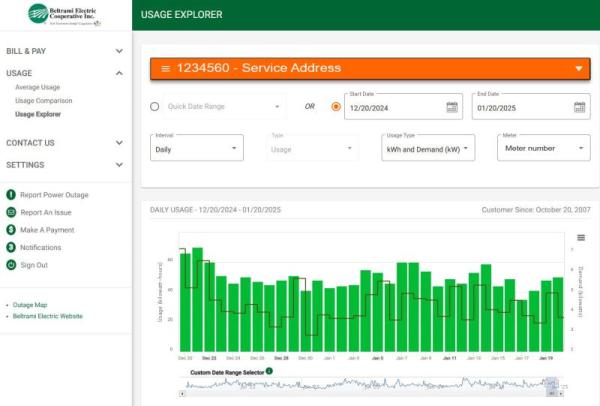Electric Rates
We work hard to keep rates affordable while committing to provide reliable electricity and excellent member service. As a not-for-profit cooperative, our rates are designed simply to cover the costs of wholesale power, transmission and distribution related costs and adequate margins.
Understanding Rates
The whole premise of electric rates in a cooperative is one of fairness. Rates charged by Beltrami Electric Cooperative are established by the Board of Directors with the advice of engineering consultants, accountants and electric rate specialists. The resulting data helps our board of directors evaluate and determine how to create cost-based rates for our members.
All factors contributing to the cost of providing safe and reliable service are tabulated and projected. This includes the cost of:
- wholesale power (The largest component of our costs at 70%)
- cost of operating and maintaining the distribution system
- accounting and sales expense
- administrative expense
- depreciation on the investment in power lines, equipment and facilities taxes
- interest on long-term debt
- margins
Generally, costs are divided into three categories:
Fixed costs - such as an Access Charge, are designed to recover some of the fixed costs to provide safe and reliable service. This could include expenses such as fleet, line maintenance, right-of-way clearing, billing/admin, and electrical equipment.
Variable costs - this is Energy (kWh) that our members use each month and can vary widely depending on weather and other factors. This rate also recovers a portion of our operating expenses.
Demand-related costs - Beltrami Electric’s wholesale rates are based on total co-op demand. We pay more for power when our members use a lot of electricity at the same time and when there is a tight supply of power generation. As demand for electricity goes up, so does our costs for wholesale power. The industry and many utilities are beginning to move to a three-part bill, with a demand charge, energy usage charge and service charge.
Monitor and view demand in SmartHub.
- Login to SmartHub
- Click on Usage/Usage Explorer
- Change Usage Type to kWh and Demand (kW)
- The dark line will show your demand over the green columns that shows your energy (kWh) usage

Rate FAQs
The Access Charge is a fixed charge for each account that accounts for the equipment and service necessary to turn on the lights whenever they’re needed or necessary – a flat monthly rate charged whether or not any electricity is consumed. It ensures that your expectations for continuous power and outstanding member service are met and gives each member a fair and equal share of the cooperative's operation. Here are some examples of what the access charge covers:
-
It allows your co-op keep pace with increased system investments to improve both capacity and reliability. It accounts for the co-op’s investment in equipment like meters, poles, wires and transformers, as well as labor to provide members with safe and reliable electric service.
-
It supports line trucks, facility and member service functions, such as line maintenance, right-of-way clearing, billing, member service support and administrative responsibilities.
-
It accounts for the infrastructure that provides members access to electricity seven days a week, 24 hours a day, 365 days a year, outage restoration and repairs.
The monthly Access Charge covers a portion of our costs for delivering electricity - including labor, billing, member service support, maintenance, and repairs to distribution infrastructure. These fixed costs exist whether or not you use a single kWh of electricity, and a cost-of-service study reported that our fixed costs grow each year. Since we have not adjusted our access charge since April 2018, the increase is $7.50/month, or about $1/year.
We continue to make investments each year in our infrastructure to replace aging lines and equipment, improving reliability and safety.
This is the rate you pay for each kilowatt-hour (kWh) used in the billing period. The amount of energy you consume can vary from month to month and can impacted by extreme temperatures.
The kWh charge represents the energy consumed during the statement reading dates and is multiplied by the current energy rate to calculate the charge. The energy rate represents costs associated with wholesale power including energy, transmission, substation and capacity charges.
-
A kilowatt-hour (kWh) is the measurement of electricity used. One kWh is equal to 1,000 watts used continuously for one hour.
-
For example: a 100-watt light bulb burning for 10 hours uses one kWh. The higher the watt rating on electrical devices, the more electricity it uses.
-
A cost-of-service study showed we need to better match the cost of peak usage with peak power costs on the grid. Adding a demand charge reflects the way your cooperative pays for wholesale power. A demand charge accounts for higher grid costs during times of peak usage. This change will better align member rates with the cost of wholesale power.
A demand charge also provides opportunities for more consumer control over electric bills by minimizing individual peak use, and – when doing so, it helps BEC lower overall peak demand. Signing up for BEC’s off-peak program is a great place to start.
What exactly is Demand?
Demand is the amount of power needed to run everything in your home at a specific time – measured in kilowatts(kW), not kilowatt-hours. There is no charge for demand at this time (currently listed at $0.00), however BEC pays more for power when members use a lot of electricity at the same time.
Members can see their demand on their bill or within SmartHub. Members may also contact our office and our member service representatives will be happy to assist you.
Demand is not new—it has always been part of your electric bill, just bundled into your energy and access charges. Now, with improved technology, we can measure demand separately, which allows for a fairer distribution of costs among all members.
Electric demand refers to the highest amount of electricity you use at one time. The cooperative must always be ready to supply enough power to meet members’ peak demand, which means investing in equipment like transformers, wires, substations, and even power plants. By billing demand separately, we ensure that those who use more power at once contribute their fair share to maintaining the system.
You can help lower your demand by spreading out your electricity use—for example, running major appliances like the oven, washer, and dryer at different times instead of all at once. This can help you manage costs while also reducing strain on the electrical system.
The purchased power adjustment is a direct pass through of changes in the average cost of purchased wholesale power from Minnkota Power Cooperative. (The adjusted cost could either be decreases or increases) This allows the cooperative more flexibility when recouping fluctuations in the wholesale energy costs instead of estimating them into an overall electric rate.
Your cooperative has held rates flat for seven years. An independent cost-of-service affirmed that it’s time to adjust rates. As a not-for-profit, member-owned co-op, our focus is on service, not profit. We only change rates when necessary to keep our service reliable, pay our loans, and stay financially stable.
Rising Costs: Costs are on the rise. Inflation, higher interest rates, and supply chain issues have increased our equipment and material costs since 2018.
Prices for crucial components like spools of wire, underground cable, transformers, metering equipment, and even basic nuts and bolts have surged over the past few years. Core steel for transformers, heat shrink tubing, copper connectors and computer chips – all critical to the electric system’s reliability — have experienced shortages and price hikes.
Since our last rate increase in 2018, the cost of a pad mount transformer – the green box that delivers energy from the distribution line to your home – has increased 140%. The cost of underground wire has increased by 63%, and the cost of a wood pole has increased by 35%. These are just a few examples of how equipment has increased over the past few years. We continue to purchase and install equipment each year - aging cable, poles that aren't sound anymore, equipment that malfunctions, in addition to refurbishing and maintaining other equipment. It's like a road or a car - if you don't make investments in regular maintenance, it may not run or hold up to normal wear and tear.
Changing Grid: The early shutdown of baseload power plants and the addition of wind and solar energy have also created supply and demand issues on the grid. When electricity demand is high and power supply is limited, Beltrami Electric pays more for power. To better align member rates with these higher costs during peak times, members will see the addition of a demand charge.
As a result of all of the above, the board of directors has approved a rate change for April 2025.
Our last rate change was in April 2018. We’ve held rates flat for seven years through wise investments in reliability and careful management of our costs. Our electric service is 99.98% reliable. That averages about one outage per member per year. Very few outages mean very little overtime pay to restore service when the power goes out. We also include employees in our strategic planning efforts – and their ideas help keep our purchasing and operating costs down.
The most important thing you can do is practice the wise use of electricity. Turning off or unplugging devices when not in use. You can find more energy saving tips here:
BEC offers several options to help you manage your electric bill. Some of those services include automatic payment options, budget billing, home energy assessments, off-peak programs and rebates.
Our energy experts can help. Call us at 218-444-2540 – for more ways to save on your electric bill.
Electric cooperatives maintain more miles of line per consumer and serve mainly rural areas that have an average of eight consumers per mile, unlike municipal or investor-owned utilities which have higher-density populations of 34 - 48 consumers to share in the cost of infrastructure.

We understand it can be frustrating to see extra line items on your bill beyond the cost of electricity. These charges—such as Minnesota state sales tax, Beltrami or Hubbard County sales tax, Beltrami County transit sales tax, City of Bemidji or Blackduck sales tax, or even the City of Bemidji franchise fees—are required by law.
Beltrami Electric is responsible for collecting these amounts and passing them directly to the appropriate government agencies. None of these funds remain with your cooperative or contribute to our operating revenue. In other words, we’re simply the “messenger” that collects and transfers these charges as required by state, county, and city regulations.
If you’d like to learn more about how these taxes and fees are set, you can contact the Minnesota Department of Revenue, Beltrami County, the City of Bemidji or the City of Blackduck for more information.
